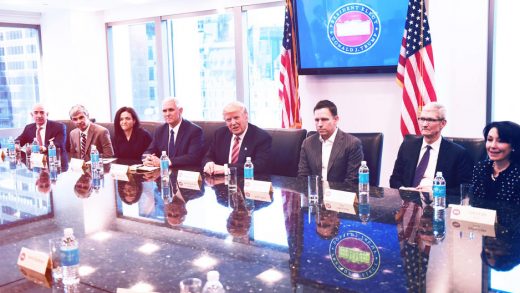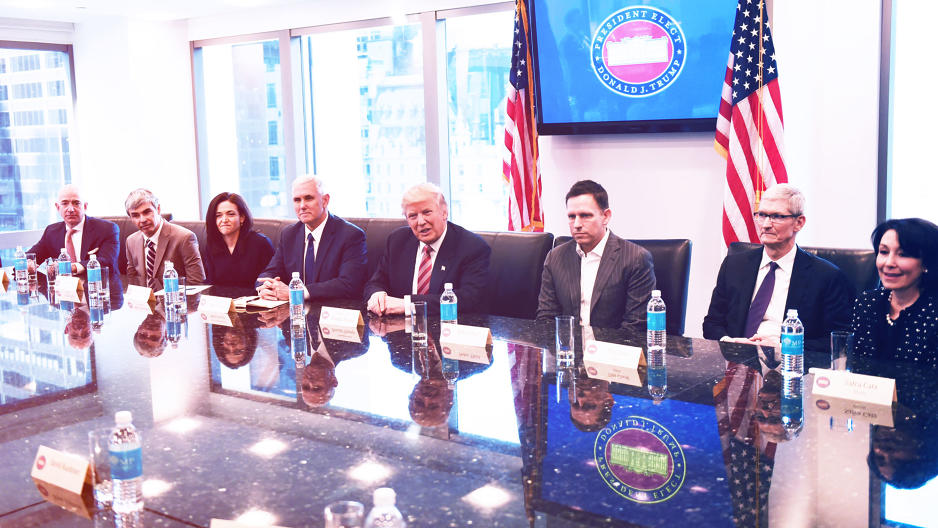How Tech Leaders Should Engage With Trump In 2017 (From Someone Who’s Been In The Room)
About nine months before George W. Bush became president, I was asked to sit on an independent tech advisory council to help the then-Texas governor understand the role of tech in the new decade. The candidate assembled a group of about 90 people to help craft a tech policy he could promote if he became president.
Three months after Bush took office, he invited the whole tech advisory board to the White House to share what were to be his administration’s tech and science goals. At the White House, I saw up close how Washington’s political machinery works—and it’s been pretty consistent. Starting with Bill Clinton, the past three administrations have maintained an open communication channel with the tech community.
Now we have a new president-elect who, beyond Twitter, isn’t tech savvy at all, and may not understand the importance of tech as an economic driver. So there is an urgent need for Silicon Valley to get his ear. But other than venture capitalist Peter Thiel, almost all of Silicon Valley supported Hillary Clinton, and many actively spoke out against Trump.
That means Silicon Valley already had two strikes against it when a dozen or so of its top leaders met with President-elect Trump in in New York City last week. Leaders like Apple’s Tim Cook made the trip for obvious reasons: Now that Trump will be president, and the stakes are so high for tech, engagement is better than silence. More important, though, the tech leaders may have wanted to make sure Trump doesn’t do anything to stifle tech innovation and investment or develop policies that will hurt Silicon Valley companies.
Unlike the last three presidents who were willing to be schooled by tech execs, Trump clearly had many biases going into last week’s meeting. And some of them sound good in stump speeches, but as real policies they’re half-baked. For instance, Trump said during the campaign that Apple should move its manufacturing to the United States.
But the reality of such a move is unlikely. Even if Foxconn could set up a factory or two in the United States, it would be largely robotic and would not create a lot of new jobs. And while Trump has threatened to slap a 35% tariff on goods made in China, consumers are not likely to embrace the idea of paying $800 for an iPhone that today costs $650.
And trade is just the beginning: Tech companies stand apart from Trump on a range of issues, including immigration reform and H1-B visas, security and encryption, and various social issues.
Engagement Or Bust
Tech execs have to mount a concerted effort to influence the new president. They must be willing to confront him directly when his policies impact tech negatively. Fortunately, reports about last week’s meeting suggest that Trump is at least willing to work with the tech world.
The Wall Street Journal reported that Trump said, “We want you to keep going with the incredible innovation. There’s nobody like you in the world … Anything we can do to help this go along, we’re going to be there for you.”
This is a more conciliatory tone than what we heard from Trump on the campaign trail, but according to reports, the discussion didn’t get very far into actual policy. At best, the meeting may have served as a start to building a bridge between the tech community and the Trump administration.
New Tech Advisory Councils
Ideally, President-elect Trump would form at least four tech councils focused on key issues impacting tech’s future. These councils would be used to help him develop a tech policy that advances the role of tech as a key part of our economic growth. They would work to create an environment where innovation can happen without excessive regulation. They would also look at how the job market of the future will be impacted by artificial intelligence and robots, and propose educational reforms to prepare a new kind of workforce.
1. Education reform. Our educational system needs to put stronger emphasis on preparing students for science and technology careers starting at an early age. As students advance to upper grades, they need dedicated course work in programing, data mining, digital security, and other skill sets. The council can help Trump include science and technology in any education reform he plans to push through.
2. Immigration reform. Many innovative U.S. tech companies depend on non-U.S. citizens who are allowed in to work under the H-1B visa program. But Trump’s stated plan to overhaul immigration could have a dramatic negative impact on the number of workers admitted under the program each year.
This council would provide tech’s perspective on immigration reform, with an eye toward doing what is necessary to keep the H-1B program in place. The council might even make the case for the expansion of the program to meet the needs of tech companies. The group would also weigh in on any immigration plans—like building “the wall”—to make sure they are fair and just.
3. Telecom and networking
New 5G technology will be a major economic driver in the coming years. It will create fast wireless broadband networks destined to deliver new forms of high-speed connectivity that will impact any connected digital service.
People on this council would ideally be experts in autonomous vehicles, smart cities, and the internet of things. They’d have knowledge of creating broad mesh networks so that they could help ensure that all types of systems can take advantage of new networks capable of greater than a gigabit-per-second speeds.
The council would advise Trump on the technology and its effects. It would help the administration develop policies that help the companies building the networks, and keep them free of stiffer regulations or negative laws. This would help bring broad deployment of 5G networks to most of the U.S. by 2020-2022.
4. The Future of transportation
The U.S. government will need to be deeply involved in the development of self-driving trucks and autonomous vehicles. The automakers and various companies like Uber and Lyft plan to have self-driving cars ready for the market as early as 2020. So many of the policies needed to make that happen will have to be developed in these four years under Trump.
The council would form federal rules on autonomous and semi-autonomous driving, and would guide state and local governments on developing their own legal frameworks.
I believe the burden of convincing Trump to create these types of councils falls on Peter Thiel, the only tech executive on his transition team. Trump has created an advisory council that includes Ginny Rometty, CEO of IBM, and Elon Musk, CEO of Tesla, but that council appears to be a broader business and economy advisory board, not one focused on technology policy and regulation.
Starting Point?
I truly hope the tech execs’ meeting with Trump last week will be the starting point for a successful relationship. If tech leaders can seriously get the ear of the president-elect and influence his thinking, Trump could actually become a friend to Silicon Valley. He is in a position to help the tech industry continue its innovative ways. He might be able to moderate the relationship so that Washington provides help when needed but does not inhibit growth with excessive regulation.
Washington’s interest in helping advance a strong tech agenda started when Bill Clinton was running for president. At that time, John Doerr of Kleiner Perkins, along with then-Cisco CEO John Chambers, began tutoring Clinton about why tech would be a major economic driver. They argued that, should he become president, he needed to a strong, inclusive, and innovation-focused tech strategy to move the country forward. Doerr and Chambers stressed the importance of startup companies and other groups focused on advancing the role of technology in the U.S.
And from there it snowballed. With the help of a lot of people in Silicon Valley, Obama’s presidency has become one of the most aggressive in helping advance the growth of tech in the U.S. Let’s try to continue on that path.
Tim Bajarin is president of the research and consulting firm Creative Strategies.
Fast Company , Read Full Story
(23)














